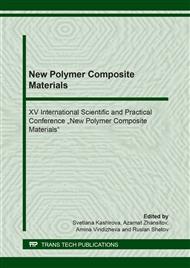[1]
D. Zhang, H. Yao, D. Zhou, L. Dai, J. Zhang, S. Yuan, Synthesis, characteristics and adsorption properties of polyphenylene sulfide based strong acid ion exchange fiber, Polymers for Advanced Technologies. 25 (2014) 1590-1595.
DOI: 10.1002/pat.3407
Google Scholar
[2]
X. Di, L. Fang, Q. Lin, T. Zhang, X. Zhou, Synthesis and characterization of silane-grafted polyphenylene sulfide, High Performance Polymers. 26 (2014) 97-105.
DOI: 10.1177/0954008313499802
Google Scholar
[3]
Y. Li, X. Zhang, G. He, F. Zhang, Sulfonated poly(phenylene sulfide) grafted polysulfone proton exchange membrane with improved stability, International Journal of Hydrogen Energy (2016) 1-10.
DOI: 10.1016/j.ijhydene.2016.09.183
Google Scholar
[4]
Y.Q. Yang, H.J. Duan, S.Y. Zhang, P.F. Niu, G. Zhang, S.R. Long, Morphology control of nanofillers in poly (phenylene sulfide): A novel method to realize the exfoliation of nanoclay by SiO2 via melt shear flow, Composites Science and Technology. 75 (2013) 28-34.
DOI: 10.1016/j.compscitech.2012.11.006
Google Scholar
[5]
V.A Sergeev, V.K Shitikov, L.G Grigor'eva, Preparation and properties of oligo- and poly-phenylenes with functional groups, Russ. chem. rev., 45 (1976) 946–958.
DOI: 10.1070/rc1976v045n10abeh002743
Google Scholar
[6]
V A Sergeev, V K Shitikov, V I Nedel'kin, Poly(arylene Sulphides) — Preparation, structure, and properties, Russ. chem. rev., 47 (1978) 1095–1109.
DOI: 10.1070/rc1978v047n11abeh002295
Google Scholar
[7]
R.Т. Hawkins, Chemistry of the Cure of Poly(p-phenylene sulfide), Macromolecules. 9 (1976) 189.
Google Scholar
[8]
Yu.A. Mikhaylin, Polyphenylene sulfide, Polymeric materials. 9 (2000) 4-5.
Google Scholar
[9]
Zh.I. Kurdanova, K.T. Shakhmurzova, A.E. Baikaziev, R.M. Mamkhegov, A.A. Zhansitov, S.Yu. Khashirova, On synthesis of polyphenylene sulfide and copolymers based on it byreaction of non-equilibrium polycondensation, Izv. Vyssh. Uchebn. Zaved. Khim. Khim. Tekhnol. 62-3 (2019) 4-14.
DOI: 10.6060/ivkkt0196203.5830
Google Scholar
[10]
Pat. US 5266674. Process for preparing arylene sulfide copolymers I M.C. Yu; Phillips PC. (1993).
Google Scholar
[11]
A.S. Shabaev, A.A. Zhansitov, Zh.I. Kurdanova, S.Yu. Khashirova, A.K. Mikitaev, New Method of Investigation of Polysulfone Thermal Destruction, Polymer Science, Series B. 59-2 (2017) 216-224.
DOI: 10.1134/s1560090417020099
Google Scholar
[12]
J.M. Adams, R.W. McCabe, 2006. Clay minerals as catalyst. In: Bergaya, F., Theng, B.K.G., Lagaly, G. (Eds.), Handbook of Clay Science. Vol. 1. Elsevier, Oxford, UK, pp.541-581.
DOI: 10.1016/s1572-4352(05)01007-x
Google Scholar
[13]
N.M. Mukhin, V.G. Buryndin, Determination of the rheological and physico-mechanical properties of polymeric materials, Methodological guidelines for laboratory studies and research work. Yekaterinburg. (2011).
Google Scholar


